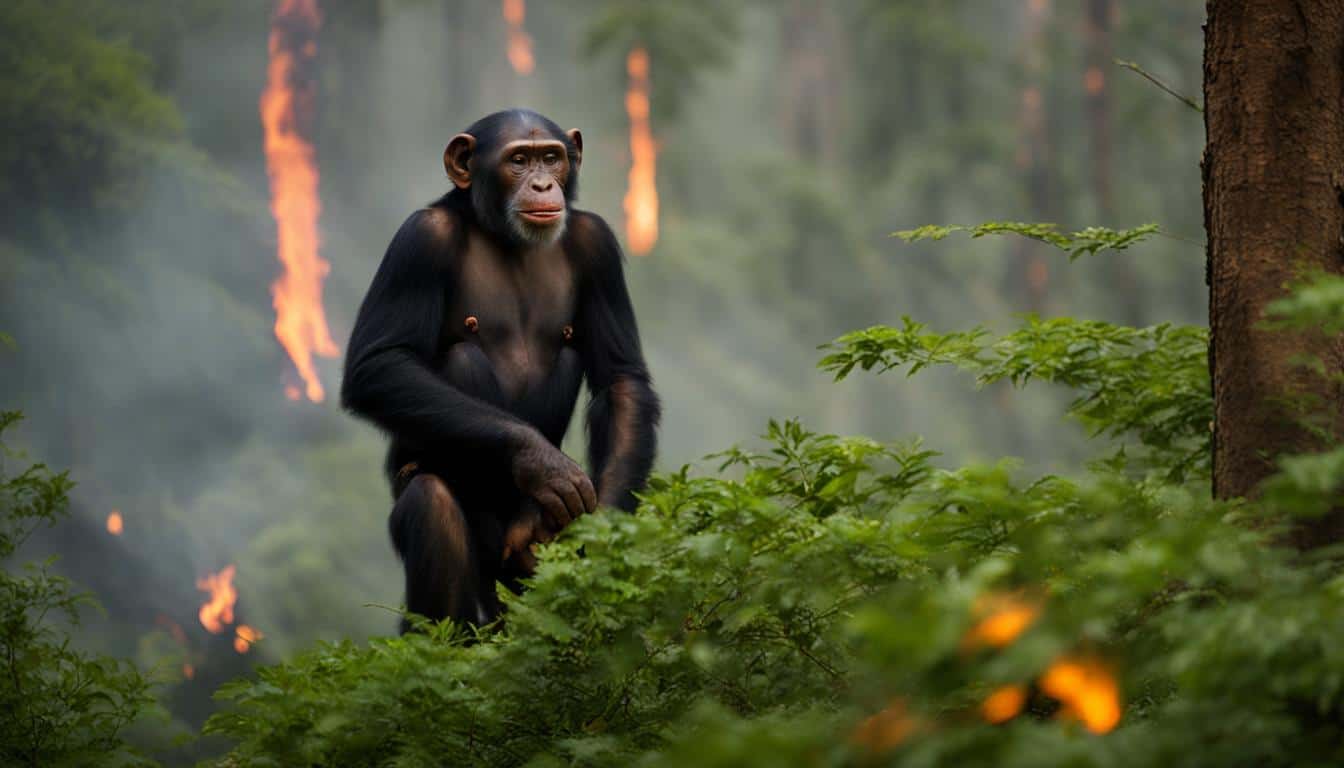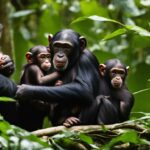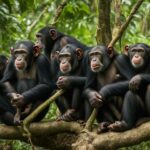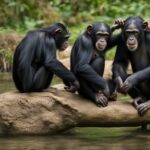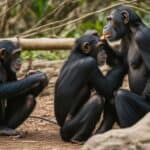Chimpanzees, our closest living relatives in the animal kingdom, have captivated scientists with their remarkable intelligence and complex behaviors. One particularly intriguing aspect of their behavior is their response to wildfires in their natural habitats.
Contrary to what one might expect, chimpanzees do not panic or flee from these fiery dangers. In fact, they display ritualistic behaviors that suggest they possess a deep understanding of fire and do not fear it. This unique behavior raises questions about the role fire plays in chimpanzee behavior and its evolutionary implications.
In this article, we will delve into the fascinating world of chimpanzees and fire, exploring how these intelligent creatures interact with wildfires in the wild and the potential impact of fire on their behavior and habitat. Through careful observation and research, scientists have uncovered valuable insights into the relationship between chimpanzees and fire, shedding light on both our own evolutionary history and the dynamics of natural ecosystems.
The relationship between chimpanzees and fire
Chimpanzees, native to fire-prone areas, have developed a unique relationship with fire. Unlike most animals, chimpanzees display a remarkable ability to monitor and predict the behavior of wildfires. They remain surprisingly calm in the midst of fires, even when surrounded by flames and smoke. This suggests that chimpanzees have a deep understanding of fire and do not fear it like other animals do.
This calmness exhibited by chimpanzees may represent a key stage in controlling fire and overcoming the fear associated with it. Similar to how early humans harnessed fire as a tool, chimpanzees have also learned to interact with fire in a way that benefits them. This interaction between chimpanzees and fire has important implications for their habitats and overall population dynamics.
By studying how chimpanzees respond to fire, researchers can gain valuable insights into fire management and its impact on primate behavior. Understanding the relationship between chimpanzees and fire is crucial for the conservation efforts of these endangered species, especially in fire-prone areas. It highlights the need to develop effective strategies to protect chimpanzees from uncontrolled fires while also recognizing the potential ecological benefits that fire can bring to their habitats.
The relationship between chimpanzees and fire
Chimpanzees show an understanding of fire and can control it in certain contexts. Their ability to remain calm in the face of fires suggests a deep-rooted relationship with this element. This understanding of fire may have evolutionary implications for our early ancestors who also likely harnessed fire as a tool. The use of fire by chimpanzees may have important consequences for their habitats and overall population dynamics.
The role of fire in chimpanzee behavior
Studies have revealed fascinating insights into the relationship between chimpanzees and fire. Chimpanzees demonstrate a remarkable understanding of fire and its potential benefits, showcasing their ability to conceptualize and control fire in certain contexts. This understanding is not limited to wild chimpanzees but has also been observed in captive apes, further supporting the idea that fire is deeply ingrained in chimpanzee behavior.
“Chimpanzees have demonstrated the ability to manipulate fire, a behavior that highlights their advanced cognitive and problem-solving skills,” explains Dr. Jane Goodall, renowned primatologist. “Their understanding of fire goes beyond mere observation, as they actively engage with it to achieve specific goals.”
Fire plays a significant role in influencing chimpanzee behavior by altering their food sources. Burned areas attract certain prey species, such as insects and small mammals, which become more abundant and accessible to chimpanzees. Consequently, chimpanzees actively seek out burned areas for foraging opportunities, making fire an essential factor in shaping their foraging strategies.
To illustrate the influence of fire on chimpanzee behavior, the table below compares the typical food sources of chimpanzees in both unburned and burned areas:
| Food Sources | Unburned Areas | Burned Areas |
|---|---|---|
| Fruits | X | X |
| Leaves | X | X |
| Insects | X | |
| Small Mammals | X |
As seen in the table, burned areas provide additional food sources in the form of insects and small mammals, supplementing the chimpanzee’s diet and impacting their feeding behaviors. This dependence on fire-altered landscapes highlights the intricate relationship between chimpanzees and fire, further underscoring the importance of studying this dynamic for a comprehensive understanding of primate ecology.
The influence of fire on chimpanzee food sources
Fire significantly affects the distribution and abundance of certain prey species, reshaping the availability and accessibility of food resources for chimpanzees. By actively seeking out burned areas, chimpanzees demonstrate a behavioral adaptation that allows them to exploit the ecological changes brought about by fire. This adaptive response highlights the remarkable resilience and resourcefulness of these primates in their ever-changing environments.
Chimpanzee Conservation in Fire-Prone Areas
Chimpanzees are highly intelligent and adaptable creatures, but their habitats are increasingly threatened by wildfires. As researchers, conservationists, and policymakers, it is our responsibility to understand and mitigate the impact of fires on these primate populations. By studying the behavior and response of chimpanzees to fires, we can develop effective conservation strategies that protect their habitats and ensure their survival.
Fires in chimpanzee habitats pose unique challenges for conservation efforts. The destructive nature of uncontrolled fires can lead to the loss of valuable resources and disrupt the delicate balance of the ecosystem. However, it is important to note that fire also plays a natural role in shaping chimpanzee habitats.
Fire can influence the behavior of chimpanzees by altering their food sources. Burned areas can attract certain prey species, providing chimpanzees with increased foraging opportunities. This demonstrates the complex relationship between fire, chimpanzees, and their ecological niche.
In order to conserve chimpanzee populations in fire-prone areas, a multi-faceted approach is required. This includes implementing measures to prevent and control wildfires, such as firebreaks and early warning systems. Additionally, efforts should be made to educate local communities about the importance of sustainable land management practices to minimize the risk of fires.
| Challenges | Conservation Strategies |
|---|---|
| Loss of habitat due to wildfires | Implement measures to prevent and control wildfires, such as firebreaks and early warning systems |
| Disruption of food sources | Work towards sustainable land management practices to minimize the risk of fires |
| Impact on predator-prey dynamics | Study and understand the complex interaction between fire, predators, and prey to inform conservation strategies |
By addressing these challenges head-on and incorporating the insights gained from studying chimpanzee behavior in fire-prone areas, we can make significant strides in chimpanzee conservation. Our collective efforts will not only protect this remarkable species but also maintain the delicate balance of their ecosystems.
The influence of fire on human evolution
The observations of chimpanzees’ interaction with fire provide valuable insights into the early use of fire by our human ancestors. The ability to control fire may have occurred at a very early stage in human evolution, possibly even before the earliest archaeological evidence of fire use by our ancestors. This suggests that the control of fire played a significant role in shaping human evolution and the development of our unique abilities and behaviors.
Fire has been a transformative force in human history, providing warmth, protection, and the ability to cook food. The control of fire allowed early humans to expand their diets and consume a wider range of foods, leading to increased nutrition and brain development. This nutritional advantage, combined with the ability to cook, may have fueled the evolution of our larger brains and complex cognitive abilities.
“Fire was the first and greatest human discovery and the most powerful weapon that Earth has ever had to offer.”
Early humans may have also used fire for social purposes, such as gathering around a fire for warmth and protection, fostering social bonds and communication. The control of fire may have played a crucial role in the development of early human communities and the sharing of knowledge and culture.
While the exact timing and methods of early fire use by our ancestors remain elusive, the observations of chimpanzees’ interaction with fire provide valuable clues and highlight the significance of fire in human evolution. Further research and exploration of early human sites and evidence are needed to shed light on the fascinating and transformative role of fire in our evolutionary history.
The Impact of Fire on the Predator-Prey Dynamic
Fire plays a significant role in altering the predator-prey dynamic within ecosystems. When fires occur, the behavior and distribution of both predators and prey can be affected, leading to changes in their interactions and survival strategies. In fire-altered landscapes, certain predator species may experience challenges in hunting due to the lack of cover and camouflage provided by the burned vegetation. This can particularly impact ambush predators such as leopards and snakes, as their successful hunting relies on stealth and surprise.
On the other hand, avian predators may benefit from improved visibility and easier prey detection in burned areas. With fewer obstacles obstructing their view, these predators can more easily spot potential prey and engage in successful hunting. The presence of fire can thus create opportunities for avian predators to thrive in these environments.
“Fire-altered landscapes can create a complex interplay between predators and prey, with some species facing challenges while others find new advantages.” – Wildlife Expert
The impact of fire on the predator-prey dynamic is a topic that requires further study to fully understand its implications. By examining how different species respond and adapt to fire-altered landscapes, researchers can gain valuable insights into the ecological nuances of these ecosystems and the intricate relationships between predators and prey.
The Interaction Between Fire and Predator Behavior
Fire can influence the behavior of predators in several ways. Some predators may actively avoid areas affected by fire, as the lack of cover can hinder their hunting success. This avoidance behavior could lead to changes in their ranging patterns and movement throughout the landscape. On the other hand, some predator species may exhibit increased activity in burned areas, capitalizing on the potential vulnerability of prey species that may be forced to seek new habitats or resources.
Understanding the intricate relationship between fire and predator behavior is crucial for comprehending the overall impact of fire on ecosystem dynamics. By examining how predators adapt to and navigate fire-prone environments, scientists can better predict and manage the consequences of fire events on both predator and prey populations.
The Importance of Studying Fire’s Influence on the Predator-Prey Dynamic
Studying the impact of fire on the predator-prey dynamic is essential for developing effective strategies in ecosystem management and conservation. By comprehending how fire alters the behavior and distribution of predators and prey, conservationists can better protect and preserve vulnerable species.
Moreover, understanding the interplay between fire and the predator-prey dynamic provides insights into the resilience and adaptability of different species. This knowledge can inform conservation efforts and policy-making, allowing for proactive measures to mitigate the negative effects of fires on wildlife populations.
In summary, fire has a profound influence on the predator-prey dynamic within ecosystems. It can create challenges for some predator species while presenting opportunities for others. By studying the interaction between fire and predator behavior, as well as the broader implications for ecosystem dynamics, we can gain valuable insights into the complex relationship between fire and wildlife.
The adaptive strategies of primates in fire-prone environments
Primate species, including chimpanzees, have developed remarkable adaptive strategies to cope with and take advantage of fire in their habitats. These strategies play a crucial role in their ability to survive and thrive in fire-prone environments. By understanding how primates respond to fire, we gain valuable insights into the ecology and evolution of these intelligent creatures.
One key primate response to fire is altered ranging behavior. When faced with wildfires, primates may actively move away from the affected areas to seek safety or to find unburned territories where food resources are still available. This ability to navigate their surroundings and make strategic decisions helps them avoid the immediate dangers posed by fire.
Additionally, fire can create unique foraging opportunities for primates. Burned areas often attract insects and small vertebrates, which become more accessible as they scurry to escape the flames. Primates take advantage of this abundance of prey, actively searching for food in these recently burned patches. The availability of such resources may influence their movement patterns and increase their foraging efficiency.
Primates also exhibit changes in vigilance and predator avoidance strategies in fire-prone environments. The presence of fire alters the landscape and can disrupt the typical predator-prey dynamic. Primates may become more vigilant and alert, actively monitoring their surroundings for potential threats. They may utilize elevated vantage points, such as trees, to better detect predators and react accordingly. By adapting their behavior to the presence of fire, primates enhance their chances of survival in these challenging environments.
Table: Primate Responses to Fire in Fire-Prone Environments
| Response | Description |
|---|---|
| Altered Ranging Behavior | Primates actively move away from fire-affected areas to seek safety or find unburned territories with available resources. |
| Increased Foraging Opportunities | Burned areas attract insects and small vertebrates, providing primates with abundant prey for efficient foraging. |
| Changes in Vigilance and Predator Avoidance | Primates become more vigilant, monitoring their surroundings and utilizing elevated vantage points to detect and avoid potential predators. |

“The ability of primates to adapt their behavior in response to fire is a testament to their intelligence and resourcefulness. By understanding their strategies, we can gain insights into how these fascinating animals navigate fire-prone environments and ultimately contribute to their conservation and survival.”
– Primate Researcher
Conclusion
The study of chimpanzees and their interaction with fire provides valuable insights into the relationship between primates and fire in natural ecosystems. Chimpanzees have demonstrated an understanding of fire and can even control it in certain contexts, challenging our previous assumptions about their response to wildfires.
Furthermore, fire plays a significant role in chimpanzee behavior and food sources. Burned areas can attract certain prey species, leading chimpanzees to actively seek out these areas for foraging opportunities. This highlights the complex interplay between fire, chimpanzee behavior, and their overall ecology.
Conservation efforts in fire-prone areas must take into account the role of fire in chimpanzee habitats. It is crucial to develop strategies that protect chimpanzees from uncontrolled fires while also considering the potential ecological benefits of fire in their habitats.
Moreover, the observations of chimpanzees’ interaction with fire offer intriguing parallels to the early use of fire by our human ancestors. The ability to control fire may have played a significant role in shaping human evolution and the development of our unique abilities and behaviors.
In conclusion, the research on chimpanzees and fire provides us with valuable knowledge about the relationship between animals and fire. It highlights the need to understand primate responses to fire, the predator-prey dynamic in fire-altered landscapes, and the adaptive strategies primates have developed to cope with and take advantage of fire in their habitats. By studying these interactions, we gain a deeper understanding of the intricate connections between animals, fire, and the natural world.
What are the typical behavioral responses of chimpanzees to wildfires in their habitats?
When chimpanzees and wildfires habitas collide, these intelligent primates often respond by retreating to safety within the forest, seeking out areas that are less impacted by the flames. They may also display signs of distress and confusion, and some may evacuate their territories altogether if the fire becomes too intense.
FAQ
How do chimpanzees respond to wildfires in their habitats?
Chimpanzees in fire-prone areas have been observed to remain calm in the face of fires, even when surrounded by flames and smoke.
What is the relationship between chimpanzees and fire?
Chimpanzees show an understanding of fire and can control it in certain contexts.
How does fire impact chimpanzee behavior?
Fire can influence chimpanzee behavior by altering their food sources and attracting certain prey species to burned areas.
How do conservation efforts address chimpanzee habitats in fire-prone areas?
Conservation efforts should consider the role of fire in chimpanzee habitats and develop strategies to protect chimpanzees from uncontrolled fires.
What is the significance of early fire use by human ancestors?
The early use of fire by our human ancestors may have played a significant role in shaping human evolution and the development of our unique abilities and behaviors.
How does fire impact the predator-prey dynamic in fire-altered landscapes?
Fire can influence the behavior and distribution of predators and prey, potentially altering the predator-prey dynamic in complex ways.
What adaptive strategies do primates use in fire-prone environments?
Primate species have developed adaptive strategies, such as altered ranging behavior and changes in vigilance and predator avoidance, to cope with and take advantage of fire in their habitats.
What conclusions can be drawn from chimpanzee and fire research?
The study of chimpanzees and fire provides valuable insights into the interplay between animals and fire in natural ecosystems.

